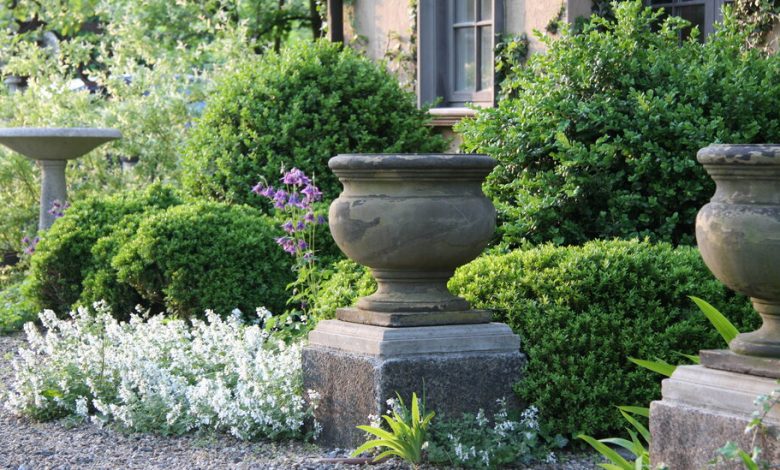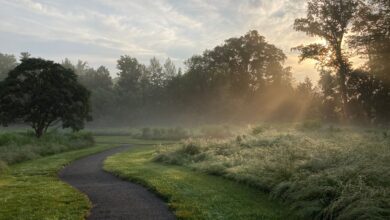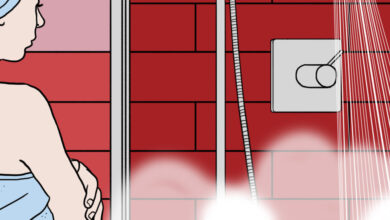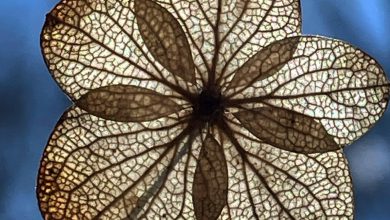Why Boxwood, a Perennial Favorite, Needs a New Approach

[ad_1]
It’s time for boxwood-loving gardeners to learn the abbreviation B.M.P. — best management practices — and get with the program. Boxwood needs our informed attention and care to do its job as the indispensable landscape element it has become since the first Buxus were planted in the United States in the mid-17th century.
It is hard to think of another plant that lends such year-round structure to a design as boxwood, defining spaces with its evergreen presence, while holding little interest for hungry deer — another big plus.
But in the last decade or so, the fungal pathogen Calonectria pseudonaviculata, which causes boxwood blight, has tarnished this garden mainstay and important nursery crop. The disease — first identified in the United States in 2011 and recorded in at least 30 states and the District of Columbia since then — has triggered a surge of research into how to control it, and into the possibility of breeding resistance into boxwood genetics.
For Andrea J. Filippone, an architect and designer of landscapes and interiors who owns AJF Design, the challenge underscores a feeling she was having years before the arrival of the disease. The conventional wisdom of boxwood maintenance — starting with regular, drastic shearing to within an inch of the plant’s life — didn’t seem to her to match boxwood’s needs.
“This plant, historically, has been mistreated,” said Ms. Filippone, who in March became president of the American Boxwood Society, an organization of enthusiasts, from nursery professionals to home growers. “We baby this plant to death. Plants are overwatered, over-fertilized and allowed only a little crust of leaves to photosynthesize with.”
She is not alone in her assessment.
“It’s our cultural decisions that have created the high numbers of susceptible plants, really,” said Margery Daughtrey, a plant pathologist and senior extension associate at Cornell University’s School of Integrative Plant Science.
Ms. Daughtrey pointed to conditions we commonly create that invite trouble: Wall-like stretches of hedging, for example, are boxwood monocultures. And there is nothing more hospitable to fungi than close quarters, where moisture can build when air and light are excluded.
Especially vulnerable are the low hedges that define traditional herb gardens or formal rose gardens, she said. They’re easy targets for disease, if rainfall or watering splashes fungal spores up from the soil onto the plants.
A New Mind-Set for the Boxwood Gardener
The bottom line: If we appreciate the value of boxwood, we must change our ways. That means choosing the most resistant varieties for new plantings and fine-tuning our care regimens for new and existing plants to a more sustainable approach — those best management practices.
These guidelines, from looser pruning to regular mulching and more, need to become what Bennett Saunders, of Saunders Brothers, called “a new mind-set of the boxwood gardener.” His Virginia-based family business, a wholesale nursery that is more than a century old, has made boxwood its “signature crop” since around 1950, he said. Today, that means focusing on breeding for more resilience against blight and boxwood leafminer, an insect pest.
Saunders Brothers has been actively selecting among cultivars for blight resistance since 2011, when the nursery had about 150 varieties in its collection to evaluate. The gardeners there began making crosses of the more resistant varieties, and now the resulting 5,000 unique seedlings need to be screened for disease and pest resistance. The process continues, but two cultivars have been introduced so far: NewGen Independence and NewGen Freedom.
“We have tested hundreds of varieties, and we have yet to find one that is completely resistant to blight,” Mr. Saunders said. “We are finding incrementally better plants — against blight and leafminer.”
At the same time, the United States Department of Agriculture’s Agricultural Research Service and a number of universities — in Oregon, Texas, Tennessee, Virginia, Maryland, Connecticut and New York — are also seeking solutions. A lot is at stake: A 2020 U.S.D.A. report estimated that more than 11 million boxwood plants are sold annually, at a market value of $126 million.
A Closer Look at Boxwood Blight
A gardener may not notice that something is wrong with boxwood until obvious symptoms like rapid defoliation occur. But blight’s first tip-off is on the foliage: brown spots with dark edges, sometimes surrounded by yellow halos. This isn’t the tan or brown coloration that results from winter injury, de-icing salt damage or drought. Blight-affected leaves usually drop, revealing black, streaky lesions on the stems.
The Connecticut Agricultural Experiment Station reports that of the most commonly grown boxwood species, Buxus sempervirens is the most susceptible to blight, followed by B. microphylla crosses with sempervirens and then B. microphylla. B. sinica is the least susceptible. However, the report cautioned, “while we can make general conclusions, there is a lot of variation within species and that has to be recognized.”
Including a variety’s shape: “Cultivar architecture is a huge determinant of blight,” Mr. Saunders said.
And the way plants perform in different regional conditions varies. No one set of recommendations will fit every garden, making breeding for regional concerns another need.
Boxwood is especially conducive to blight during prolonged periods when the foliage remains wet or humidity is high, particularly when temperatures are between 60 and 77 degrees. The fungus may go temporarily dormant during hot, dry periods or winter cold. A climate like Atlanta’s may have conditions favorable for blight during many months of an average year. And extra-rainy growing seasons, like 2018’s in the Eastern United States, can cause epidemic-level outbreaks.
The sticky pathogen can be spread by tools and other equipment, on clothing or by moving infected plants and plant debris. Spores once introduced can live in the soil for years. And boxwood family relatives Pachysandra and sweet box (Sarcococca) can also be hosts to the fungus.
Making New Choices, for the Moment
Ms. Filippone never thought of herself as a boxwood type until 1992, when she bought an 18th-century dairy farm in Pottersville, N.J., that came not with cows, but deer.
How could she create the defining, evergreen elements of the formal, historic-style landscape that she craved and that her architecture-trained eye imagined? Thirty or 40 visiting deer, she knew, would make short order of hedges of yew (Taxus).
The answer: boxwood.
Today, the place where she and her husband, Eric T. Fleisher, of F2 Environmental Design, live and garden is called Jardin de Buis, or garden of boxwood. Their property, where they operate a small boxwood nursery, is a popular destination on Garden Conservancy Open Days (June 12 this year).
Ms. Filippone has long appreciated and shown off “the nuances of boxwood,” its range of shapes and even variations in leaf color and texture among cultivars.
But as much as she loves particular ones to create the perfect globe, mound or pillar, certain favorites don’t hold up to today’s disease pressure. So she is taking a pause on using them, especially some of the dwarf types.
Likewise, at Saunders Brothers, former mainstay classics like dwarf English boxwood (Buxus sempervirens Suffruticosa) are no longer offered for sale.
“You don’t want to make all your boxwood choices related to blight,” Ms. Daughtrey said. “But it’s such an eliminator that perhaps, for a while, we should choose based on whether they will make blight more or less likely.”
B.M.P. for Growing Boxwood at Home
There is no cure for blight — even chemical fungicide sprays are only preventive — but there is a tool kit of cultural tactics offering gardeners the best chance for success.
“Fungicides aren’t medicine; they’re protectants,” Ms. Daughtrey said. Affected plant parts must be removed and destroyed before management with fungicides is attempted. Always bag all debris — don’t compost it — and apply a thin layer of fresh mulch to cover fallen leaves, reducing inoculum.
As with leafminer, which is more often seen on cultivars commonly grown in Northern areas, blight must be managed. (In 2021, another pest, the box tree moth, entered the United States on nursery plants from Canada, but it’s too soon to know how its presence will unfold, or what its impact will be.)
Our main goals are light and air. Studies have shown that leaving a boxwood shaggier reduces blight. Again: low hedges are particularly susceptible, so pruning up a bit to encourage air movement underneath the plants is helpful. Cleaning tools frequently with a disinfectant also helps prevent transmission.
“If we could eliminate even just that low-hedge type of planting, all the others would do better,” said Ms. Daughtrey, who has worked with colleagues to compile more information at BoxwoodHealth.org. “The taller a plant is and the farther from the ground, the more air it’s catching and the better it looks.”
Some tactics are simple (and reminiscent of tomato best practices): Don’t water overhead; don’t work among plants when the foliage is wet.
And don’t forget to mulch: Research by Chuanxue Hong, a professor of plant pathology at Virginia Tech, has shown that a mulch layer is up to 97 percent effective at blocking spores that would otherwise splash up onto plants.
“A leaf that might have fallen off an infected plant the year before can’t come back and haunt it again if it’s buried,” said Ms. Daughtrey, who is looking forward to a rapid test for blight that is in development — and to the fruit of collaborative efforts to build a better boxwood today.
Margaret Roach is the creator of the website and podcast A Way to Garden, and a book of the same name.
For weekly email updates on residential real estate news, sign up here. Follow us on Twitter: @nytrealestate.
[ad_2]
Source link






